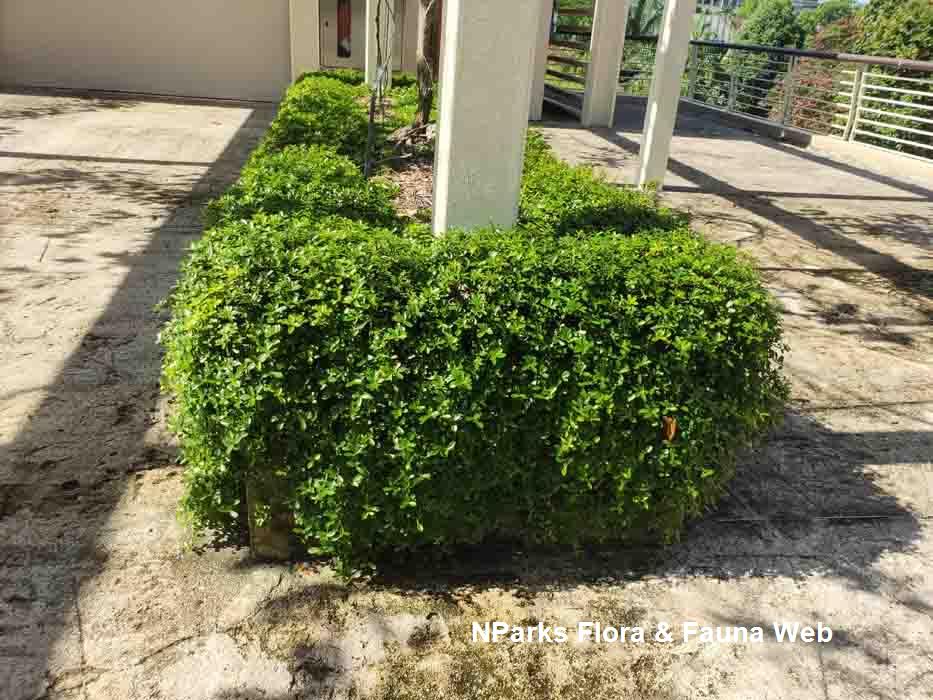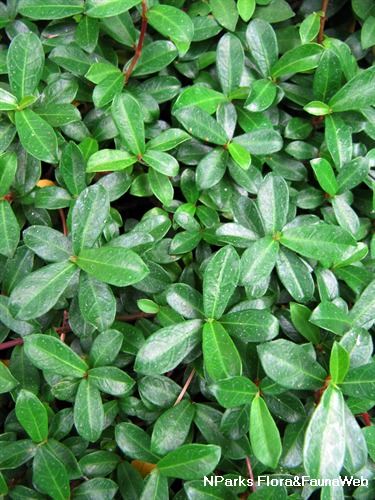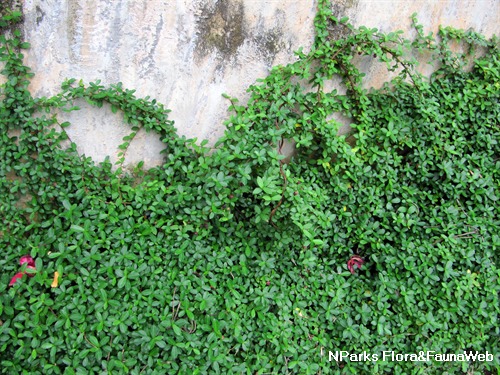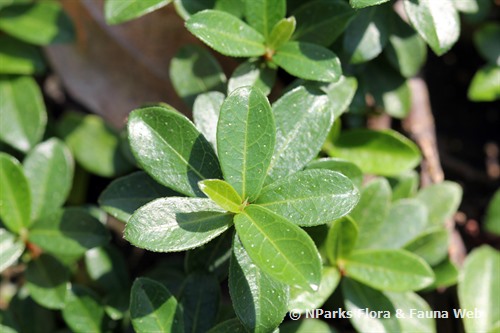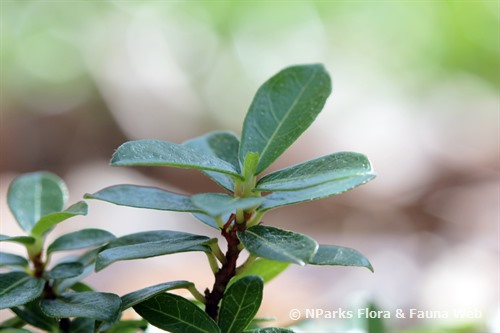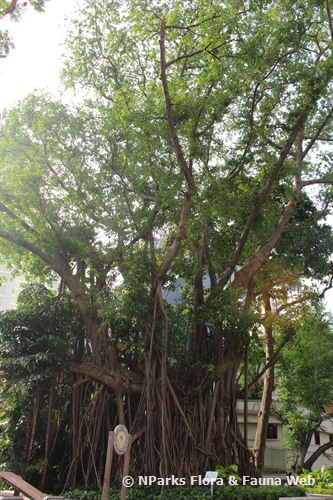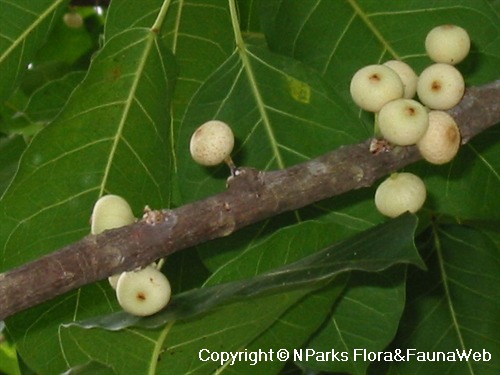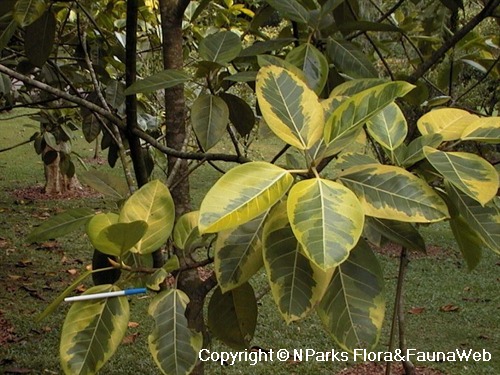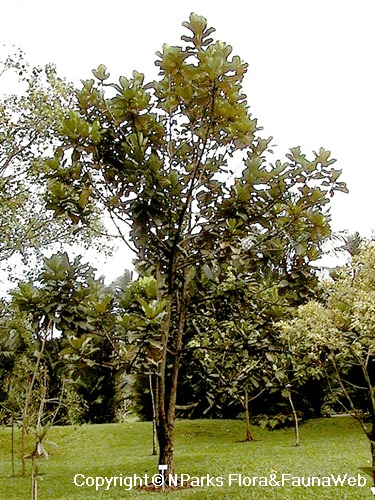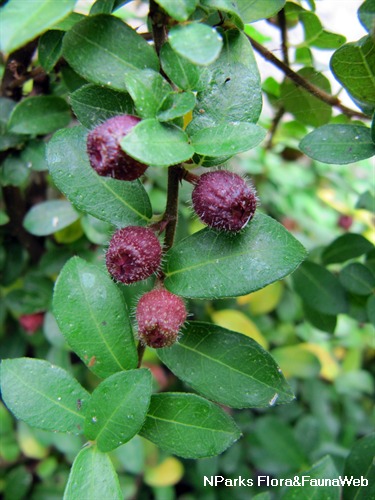
Name
Classifications and Characteristics
| Plant Division | Angiosperms (Flowering Seed Plants) (Dicotyledon) |
|---|---|
| Plant Growth Form | Creeper |
| Lifespan (in Singapore) | Perennial |
| Mode of Nutrition | Autotrophic |
Biogeography
| Native Distribution | South Taiwan |
|---|---|
| Native Habitat | Terrestrial (Coastal Forest), Shoreline |
| Preferred Climate Zone | Sub-Tropical / Monsoonal |
| Local Conservation Status | Non-native (Horticultural / Cultivated Only) |
Description and Ethnobotany
| Growth Form | It is a trailing or scrambling shrub with a prostrate growth form. |
|---|---|
| Foliage | The simple, obovate-elliptic leaves are 1-1.5 cm long and 0.4-0.7 cm wide, arranged alternately along the stem. The leaves are papery and have coarse hairs on the leaf upper surface. The lower leaf surface is covered with cystoliths. The leaf stipules are red and lanceolate in shape. |
| Stems | The stems are puberulent and root at the leaf nodes. |
| Fruit | The globose to ovoid fruits are about 1 cm in diameter, borne in the axillary leaf nodes and turn purple-black when ripe. The surface of the fruit is covered sparsely with coarse hairs. |
| Habitat | It grows on rocks in coastal forests and littoral thickets. |
| Associated Fauna | Its flowers are pollinated by fig wasps, and the ripe figs are probably eaten by birds or small mammals. |
| Cultivation | It can be propagated by seed and stem cuttings. |
| Etymology | Latin Ficus, fig; Latin vaccinioides, resembling Vaccinium species (such as blueberries), referring to the dark purplish figs. |
Landscaping Features
| Landscaping | It is suitable for growing as a groundcover, or on concrete retaining walls. |
|---|---|
| Desirable Plant Features | Ornamental Foliage, Ornamental Fruits |
| Landscape Uses | Parks & Gardens, Small Gardens, Coastal, Beachfront / Shoreline, Suitable for Rooftops, Vertical Greenery / Green Wall, Groundcover, Skyrise / Balcony, Suitable for Hanging Baskets |
Fauna, Pollination and Dispersal
| Pollination Method(s) | Biotic (Fauna) |
|---|---|
| Seed or Spore Dispersal | Biotic (Fauna) |
Plant Care and Propagation
| Light Preference | Full Sun, Semi-Shade |
|---|---|
| Water Preference | Moderate Water, Little Water |
| Plant Growth Rate | Moderate |
| Rootzone Tolerance | Drought Tolerant, Moist Soils, Well-Drained Soils, Saline Soils / Salt Spray |
| Propagation Method | Seed, Stem Cutting |
Foliar
| Foliage Retention | Evergreen |
|---|---|
| Mature Foliage Colour(s) | Green |
| Mature Foliage Texture(s) | Hairy / Hirsute, Papery |
| Foliar Type | Simple / Unifoliate |
| Foliar Arrangement Along Stem | Alternate |
| Foliar Attachment to Stem | Petiolate |
| Foliar Shape(s) | Non-Palm Foliage (Obovate, Elliptical) |
| Foliar Venation | Pinnate / Net |
| Foliar Margin | Entire |
| Foliar Apex - Tip | Acute |
| Foliar Base | Cuneate, Rounded / Obtuse |
Floral (Angiosperm)
| Flower & Plant Sexuality | Unisexual Flowers , Dioecious |
| Flower Grouping | Cluster / Inflorescence |
|---|
| Flower Location | Axillary |
| Inflorescence Type | Syconium |
Fruit, Seed and Spore
| Mature Fruit Colour(s) | Black, Purple |
|---|---|
| Mature Fruit Texture(s) | Hairy / Hirsute |
| Fruit Classification | Multiple Fruit |
| Fruit Type |
Image Repository
Others
| Master ID | 29679 |
|---|---|
| Species ID | 3988 |
| Flora Disclaimer | The information in this website has been compiled from reliable sources, such as reference works on medicinal plants. It is not a substitute for medical advice or treatment and NParks does not purport to provide any medical advice. Readers should always consult his/her physician before using or consuming a plant for medicinal purposes. |

.jpg)
